Nettle, A Treasure Of Benefits !!

Its bad reputation has earned for years a systematic uprooting in our gardens, unjustly hated, archetypal weed that is more stinging and burning, nettle yet full of hidden treasures. we are far from imagining the innumerable qualities offered by the Nettle. More precious than threatening, we realized that the big nettle or Urtica Dioica is an essential plant with great nutritional value and endowed with inestimable medicinal virtues.This all-purpose plant well known for its therapeutic faculties, is also used in cooking, in the textile industry, and in organic agriculture.
 Learn more about this plant with a thousand virtues
Learn more about this plant with a thousand virtues

The nettle proliferates in the wastelands, in the countryside, along the roads and low walls but it also happens to settle in our gardens.
Nettle is a plant of the Urticaceae family. With more than thirty species, among the varieties of nettle, one can distinguish the burning nettle, the nettle with pill, the nettle with membrane and the stinging nettle, however, the most popular, the one which is endowed with remarkable therapeutic virtues and that which will be approached here is the big Nettle.
Also known as Stinging Nettle or Urtica, Nettles are herbaceous plants, with vegetative reproduction, which can be very invasive because they spread quickly by its rhizomes and extend easily over a very large surface. It is easily recognized by hairy leaves, petiolate, serrated with an elongated limb and pointed.

It is also unambiguously identified because its quadrangular stem and leaves are covered with tiny darts containing an irritating cocktail of histamine, serotonin and acetylcholine. At the slightest touch, these needles break, penetrate the skin, and inject the stinging liquid, giving an unpleasant sensation of burning and itching. At flowering, the plant gives birth to flowers without petals, with two sepals. Dioecious plant, we recognize the female plant thanks to its hanging flowers, greenish with purplish reflection, and the male Nettle thanks to its spreading and yellowish flowers.
 Origin and history
Origin and history

Originally from the temperate regions of Eurasia, the Nettle gradually became naturalized at the four corners of the planet. A true treasure of nature, the Nettle is a plant that has nourished our ancestors for millennia,
In ancient times, nettle was a venerated plant. The Greeks, who were very fond of it, consumed it as a vegetable in the spring; and the Roman naturalist Pliny the elder, specifies in his monumental Natural History that the nettle was "of religious observation for many", and supposed to protect diseases for the year.
Called Alkalyphe by ancient Greeks, Nettle was used to treat rheumatism, cough, tuberculosis, arthritis as well as to stimulate hair growth.
It is also used in many fields. In the sixteenth century, it was used in the manufacture of paper, rope, sail, clothing, fishing net and other. In China, a variety of nettle was even used to make banknotes. In the seventeenth century, it was reputed to cure the disorders of the respiratory tracts and the diseases of the blood vessels.
Ayurvedic medicine also used Nettle in combination with other herbs to treat uterine bleeding, nosebleeds, rashes and eczema.

Nettle has a special place in German culture, especially in northern Germany. It is found in the Coat of Arms of Schleswig Holstein (12th century) and in a Grimm's tale "Demoiselle Maline" inspired by a popular tradition from the same region. It was grown on a large scale for its textile fiber in the nineteenth and early twentieth centuries.
In Scandinavia, it was dedicated to Thor (the equivalent of the German Donar), also used for its textile fiber, and nettle seeds were found in Viking tombs.
This veneration of the ancient Indo-European peoples for nettle certainly dates back to thousands of years before the Christian era; Moreover, the word for the nettle in Latin" VRTICA" is almost the same as in Sanskrit" VRSCIKA", a sign that the two words have the same linguistic root, exactly as the word for fire in both languages.
Nettle is one of those wild plants that have never been studied scientifically thoroughly. Indeed, very few analyzes are available and the mode of action of this plant has not been elucidated clearly. However, what is certain is that this plant is a remarkable treasure of nature.
 Composition of the nettle leaf
Composition of the nettle leaf

First of all, the more quality the soil has, the older the plant, the higher the nutritional value. However, special attention must be paid to the growing area because the Nettle accumulates not only good minerals, but also pollutants and heavy metals such as lead.
The nettle leaf contains very large quantities of carotenoids (6 different, including B-carotene), folic acid (vit B9), vitamins C and E, calcium, iron, magnesium, zinc, boron and Selenium. There are also, in smaller quantities, vitamins B1 (thiamine), B2 (riboflavin), B3 or PP, B5 (pantothenic acid), B6 (pyridoxine), D and K, as well as many minerals: Manganese, Sodium, Copper, Sulfur, Iodine and Chromium.
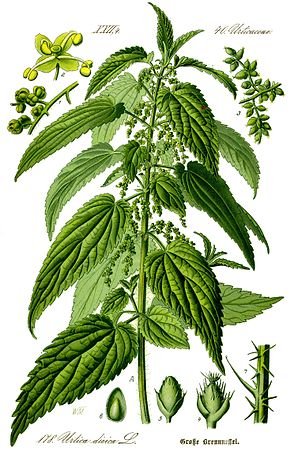
Note that Calcium is associated with the Boron, which facilitates its assimilation, which makes the nettle an interesting dietary supplement in the prevention of osteoporosis. While iron is associated with vitamin C, which promotes its absorption by the body.
Nettle leaf also contains a large quantity of 18 different amino acids (out of 20 existing), including the 8 essential amino acids (isoleucine, leucine, lysine, methionine, phenylalanine, threonine, tryptophan and valine) necessary for the development of the organism . By comparison, cereals are all deficient in lysine (some also tryptophan), while legumes are deficient in methionine. The nettle leaf, it contains the 8 essential amino acids in harmonious proportions, making it a complete food.
The nettle leaf still contains, among others, chlorophyll in large quantities, silica, flavonoids (quercitin), secretin (hormone stimulating the activity of the pancreas). Some are rare components, such as choline acetyl transferase, an enzyme synthesizing acetylcholine, with nettle being the only known plant to possess this enzyme. If one was not yet convinced of it, it is the proof that the nettle is not a plant like the others.

In fact, nettle is itself a complex of natural vitamins and minerals, moreover, complete and better balanced than synthetic products sold in pharmacies. No need to buy anti-oxidant cocktails style: vit. A, C, E + Selenium and Zinc. They are all in the nettle.
The vitamins and minerals contained in nettle are those which the modern man is most often deficient, because of his denatured industrial diet: calcium, iron, magnesium, selenium, vitamin C etc.

![]() Medium Dosing Element
Medium Dosing Element
 Energy value ± 76,4 Kcal / 100 g
Energy value ± 76,4 Kcal / 100 g
 Water 76.9 to 80 g / 100 g
Water 76.9 to 80 g / 100 g
 Fibers 2 to 5.3 g / 100 g
Fibers 2 to 5.3 g / 100 g
 Ash 4 to 5.6 g / 100 g
Ash 4 to 5.6 g / 100 g
 Calories 57 to 82 Kcal / 100 g
Calories 57 to 82 Kcal / 100 g
 Proteins 4.6 to 8 g / 100 g
Proteins 4.6 to 8 g / 100 g
 Lipids 0.7 to 1.6 g / 100 g
Lipids 0.7 to 1.6 g / 100 g
 Carbohydrates 7.1 to 12.7 g / 100 g
Carbohydrates 7.1 to 12.7 g / 100 g
 Calcium 60 mg at 3.24 g / 100 g
Calcium 60 mg at 3.24 g / 100 g
 Phosphorus 10 to 673 mg / 100 g
Phosphorus 10 to 673 mg / 100 g
 Iron 7.8 to 13.4 mg / 100 g
Iron 7.8 to 13.4 mg / 100 g
 Sodium 1 to 16 mg / 100 g
Sodium 1 to 16 mg / 100 g
 Potassium 400 mg to 2.044 g / 100 g
Potassium 400 mg to 2.044 g / 100 g
 Magnesium 7 to 399 mg / 100 g
Magnesium 7 to 399 mg / 100 g
 Manganese 3 at 3.31 mg / 100 g
Manganese 3 at 3.31 mg / 100 g
 Zinc 0.9 to 1.87 mg / 100 g
Zinc 0.9 to 1.87 mg / 100 g
 Copper 0.52 to 1.59 mg / 100 g
Copper 0.52 to 1.59 mg / 100 g
 Boron ± 3.05 mg / 100 g
Boron ± 3.05 mg / 100 g
 Selenium ± 2.7 μg / 100 g
Selenium ± 2.7 μg / 100 g

It is also found in vitamin-rich orti, including vitamins B1, B2, B5, B6, B9, vitamin C. Nettle is also one of the few source plants of balanced leaf protein in essential amino acids:
 Pro-Vitamin A or Carotenoids 0 to 6 mg / 100 g
Pro-Vitamin A or Carotenoids 0 to 6 mg / 100 g
 Vitamin B1 or
Vitamin B1 or  Thiamine 15 μg at 0.15 mg / 100 g
Thiamine 15 μg at 0.15 mg / 100 g
 Vitamin B2 or Riboflavin 0.12 to 0.23 mg / 100 g
Vitamin B2 or Riboflavin 0.12 to 0.23 mg / 100 g
 Vitamin B3 or vit. PP or Niacin 0.1 to 1.45 mg / 100g
Vitamin B3 or vit. PP or Niacin 0.1 to 1.45 mg / 100g
 Vitamin B6 or Pyridoxine ± 68 μg / 100 g
Vitamin B6 or Pyridoxine ± 68 μg / 100 g
 Vitamin B9 or folic acid ± 212 mg / 100 g
Vitamin B9 or folic acid ± 212 mg / 100 g
 Vitamin C 18.8 to 350 mg / 100 g
Vitamin C 18.8 to 350 mg / 100 g
 Vitamin E or α-Tocopherol ± 14.4 mg / 100 g
Vitamin E or α-Tocopherol ± 14.4 mg / 100 g
 little secret world of nettle
little secret world of nettle
Nettle is a real breeding ground for biodiversity. She lives in fertile environments, frequented or having been frequented by man. It is found sometimes in full sun, sometimes at the bottom of a shady valley. It likes to grow in fresh and light soil, its only requirement is the presence of fresh organic matter in the soil.
It never grows alone and is accompanied by a multitude of plants and insects. On its own, it is a true ecosystem where insects and rodents coexist. It is of great importance for its environment since no less than thirty species of insects live thanks to it and would disappear if the plant was eradicated. A hundred others, occasionally or indirectly benefit from his presence.

For example, it is a very rich food for leafhoppers and psyllids, major consumers of sap.
There are also butterflies and caterpillars feeding on its leaves and sheltering there to complete their development cycle. A colony of caterpillars is able to bare a nettle plant, which forces the plant to make a new shoot.
The butterflies that we can meet are the peacocks of the day, the moths, the marten shell (which is equipped, as its host, formidable stinging hairs) but also the choreutide.
 Nettle an ecological niche
Nettle an ecological niche
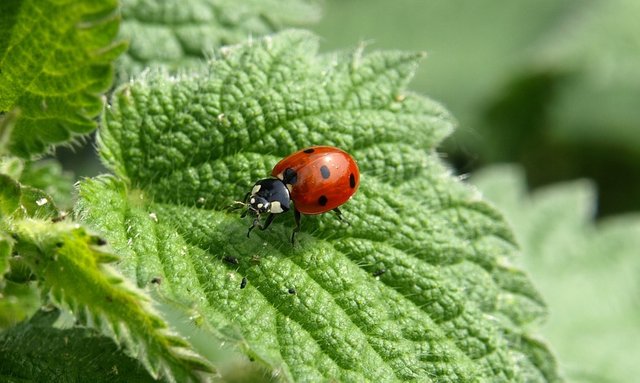
Nettle is an important ecological niche for many insects that find a nesting place, but also shelter and cover. She is the host of several species of butterflies that without it, do not frequent your garden! Studies have also shown that nettles attract aphids and their predators, ladybugs and cantharides.
If you leave a small corner dedicated to nettles not far from your crops they will be less attacked by pests. Nettle is therefore a very good tool in the fight against aphids.
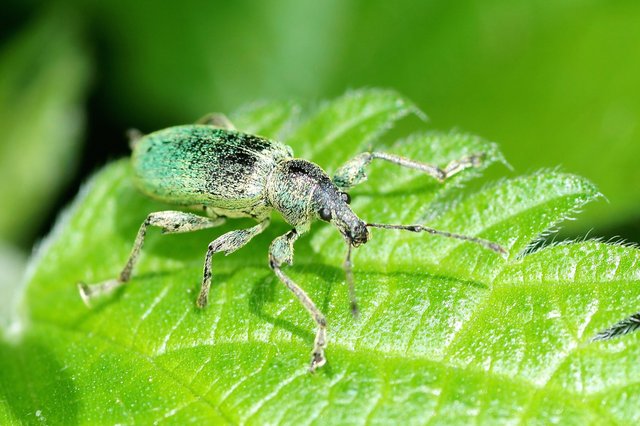
This plant, once transformed into purine is a fertilizer of choice for your crops both in the garden and for houseplants. In prevention, manure also serves to ward off parasitic insects. Do not discard the leaves used to make the manure because once added to the compost they constitute an activator of the first order.
Finally, some gardeners add a handful of nettle leaves to the bottom of the hole during planting. By releasing nitrogen, they would support crop departure, making plants more vigorous and less susceptible to disease and pests.
 Why does nettle sting?
Why does nettle sting?

the plant is entirely covered with hairs, the longest of which are like needles. Each hair is strong enough to penetrate through the skin (the inner wall of the hair is reinforced with silica, a chemical substance found in stone or glass) but also fragile enough to break on contact with the skin. and release its stinging liquid. This fluid is rich in formic acid, ants and bees also make this substance to protect themselves from their aggressors.
 Reputed médicinal plant
Reputed médicinal plant

Ever since men have used nettle to treat common ailments: its juice stops bleeding whether applied to a wound or to stop nosebleeds. It is also a traditional female remedy that significantly reduces excessive menstrual flow, fights anemia and stimulates the rise of milk.
Nettle also has a well-known depurative power: used as a diuretic, it fights the phenomenon of water retention, gout, and kidney stones.
The anti-inflammatory properties of its root make the nettle the ideal plant to treat arthritis, studies are also underway on the subject.
Contrary to what one might think, its juice relieves insect bites and itching,In herbal tea it can cure respiratory problems such as hay fever or asthma.

 Nettle and health:
Nettle and health:
 Main medicinal properties of nettle
Main medicinal properties of nettle

Considered by our ancestors as a panacea, Nettle has a therapeutic effect from leaves to flowers, from root to stem. Each part of the plant contains a good amount of its active ingredients. As a medicinal plant, the Nettle has amazing and prodigious virtues. Thus, it is recognized adaptogenic properties, tonic, diuretic, detoxifying, depurative, remineralizing, painkiller and anti-inflammatory.
Nettle is first of all interesting for its medicinal properties. Diuretic and draining, it helps fight against joint pain (rheumatism), lumbago, sciatica and gout. It is used for liver and kidney drainage, and it would also help fight urinary stones.
For these applications, take it in cures, herbal tea or in the form of fresh plant extract. Against inflammatory pain (rheumatism), try it also as a poultice: chop fresh leaves, mix them with green clay (which will give consistency to the texture and improve efficiency), and apply on the zones painful, leaving at least 30 minutes.
It is also lent anti-infectious virtues: for mouth problems (mouth ulcers, gingivitis) and infections of the throat (tonsillitis), mouthwashes and nettle infusion gargles can give good results. In external use, applied in lotion, it is an ally of choice against acne and eczema.
For gentlemen, know that nettle root, in decoction, is recommended against prostate hypertrophy.
Finally, advice to young mothers who breastfeed their baby: nettle is a galactogenic plant and it stimulates the production of milk.

 Nettle friend of the woman
Nettle friend of the woman

Its iron richness makes nettle the ideal plant for fighting anemia. Natural anti-anemic, it is especially useful for women who have heavy periods.
The young mother will then consume it in the form of herbal tea and, a benefit never arriving alone, it will also benefit from the high content of the iron plant. Ideal, therefore, to regain form after childbirth.
also, nettle is helpful in a few other treatments, such as:
 acidosis since it is alkaline and stimulates the excretion of nitrogenous waste
acidosis since it is alkaline and stimulates the excretion of nitrogenous waste
 haemorrhages since it is astringent
haemorrhages since it is astringent
 immune deficits since it is adaptogenic
immune deficits since it is adaptogenic
 allergies since it is antihistamine
allergies since it is antihistamine
 hypertension
hypertension
 venous insufficiency...
venous insufficiency...
 Diet and cooking: food supplement and food in its own right
Diet and cooking: food supplement and food in its own right

nettle has always been used by farmers to feed animals: dried, it is an excellent feed, chopped it is added to the food of poultry or even pigs. Melted with oats, it strengthens the hair and ensures the shine of their dresses.
In our diet, it constitutes a significant contribution of iron. It will be consumed in soup, omelette or dressed like spinach or chard.
From a nutritional point of view, nettle is rich in vitamin C, A and group B. It is remineralizing thanks to its content of iron, calcium, magnesium, potassium and phosphorus. It is therefore a good natural stimulant, useful for dealing with small drops in shape.
It is consumed as a food supplement, or as a real food. It is used in soups and soups, can also be used as a substitute for spinach, mix with mashed potatoes, or serve as a basic ingredient for quiches and other savory pies.
 In the kitchen
In the kitchen

Nettle is probably part of the early vegetables consumed since the dawn of time. Today it enjoys only the status of occasional vegetable, except for certain places like the Himalayas where it is considered a food in its own right.
do not forget that nettle is one of the "food" and "medicine" plants, and that by consuming it, it is first of all your health that you reinforce.
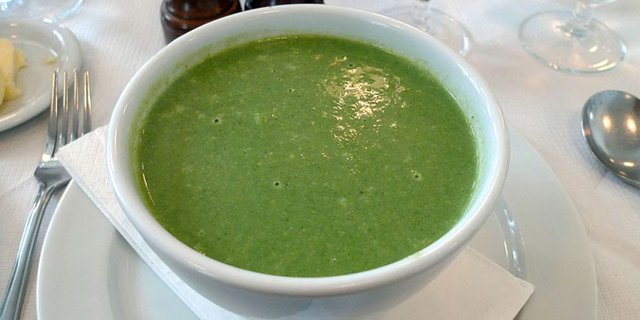
You can taste its tender leaves and fresh, raw salad although in general we prefer cooked cooked like spinach soup like sorrel with or without cream, pie, chutney, quiche. It is well worth the spinach and is as rich in protein as some meats!
The best way to take advantage of its benefits is to consume it as a spring cure to regenerate and revitalize the body at the end of the winter. For this, consume for a period of 15 days to 3 weeks, during the meal, at least once a day.
In your kitchen, many recipes of soups, velvets, quiches or other jams exist to the delight of your taste buds.

I invite you to discover original recipes based on nettle:
![]() Recipe for nettle soup For 4 to 6 people:
Recipe for nettle soup For 4 to 6 people:
 150 g of nettles,
150 g of nettles,
 2 to 3 large potatoes, garlic, chicken broth, crème fraîche.
2 to 3 large potatoes, garlic, chicken broth, crème fraîche.
In a liter of chicken broth, cook the young nettle sprouts with the potatoes. Mix and season, add the cream when serving.
 Quick recipe of nettle soup:
Quick recipe of nettle soup:
Pick up by putting on gloves, a handful of fresh leaves per person that you will chop menu after washing them. Then melt a knob of butter (or a little olive oil) in a saucepan, add the nettles and some sliced potatoes (about one per person). Cover with a liter of water, salt, pepper and cook for a good half hour. Spend and add, before serving, 3 spoonfuls of cream.
 Nettle in the garden
Nettle in the garden

Nettle grows in a soil rich in nitrogen: tomatoes that are greedy plants, will appreciate, if they are planted in lean ground, a handful of nettle (without seeds) in their hole of plantation to provide them with nitrogen during the season but a supply of liquid manure will do just fine. This nettle manure is an excellent liquid fertilizer to use diluted foot vegetables.
 Nettle preparation
Nettle preparation
Nettle manure is a herbal preparation fermented in water that gives off a foul odor, so it is best to prepare it at the bottom of the garden, for example.
 Roughly chop a kilo of fresh nettles and put them with 10 liters of water in a large plastic or wooden container.
Roughly chop a kilo of fresh nettles and put them with 10 liters of water in a large plastic or wooden container.
 Cover the container.
Cover the container.
 Mix each day as long as the mixture ferments (presence of small bubbles) for about two weeks. The time can be halved if the weather is very hot.
Mix each day as long as the mixture ferments (presence of small bubbles) for about two weeks. The time can be halved if the weather is very hot.
 When the bubbles disappear, the fermentation is finished, you can filter the preparation to keep it cool in opaque containers of glass or plastic.
When the bubbles disappear, the fermentation is finished, you can filter the preparation to keep it cool in opaque containers of glass or plastic.
 Filtered after 3 days, this preparation looks like tea that you can use spray on plants to scare away insects and limit disease.
Filtered after 3 days, this preparation looks like tea that you can use spray on plants to scare away insects and limit disease.
 Nettle in cosmetics: shampoos and lotions
Nettle in cosmetics: shampoos and lotions

Nettle is also used in cosmetics, especially in hair care. It helps solve dandruff problems and reduces sebum production. It is therefore found in shampoos, and it is possible to use it in lotion (which you can prepare yourself, as a herbal tea), after rinsing the shampoo, for soft and shiny hair.

 Dosage of Nettle
Dosage of Nettle

Harmless, safe and without any trace of toxicity, Nettle can be consumed daily, in cooking as in herbal medicine. It is also used as a poultice or externally for pain and for the care of the skin and hair. Although effective whiplash, Nettle is recommended in the long term to provide the body its vigor.
However, a cure or a treatment over a long period requires a stop of one month every 3 months. If contact with the hair does not bother you, chewing the fresh leaves as is ideal. It is better to consume Nettle in infusion or herbal tea. The roots can be used in decoction or herbal tea while the leaves in infusion.
Savory, sweet and velvety, it can enter the preparation of a soup or a juice, but it should be noted that cooked, it can lose a small part of its active ingredients. Moreover, stimulating plant, it is recommended not to consume the Nettle in the evening before going to bed.
 Manual
Manual
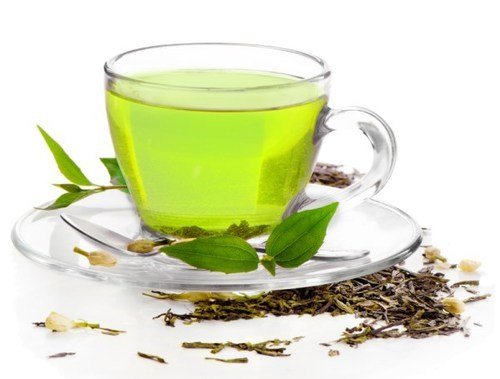
The hot water having a power of extraction of the minerals, and in particular silica, much more marked on the nettle than on many other simple, one can only advise to privilege the consumption of this plant in the form of herbal tea .
Nothing prevents moreover to consume this herbal tea up to a liter a day as it is beneficial in every way!
In order to make it, fifty grams of leaves and roots per liter of water will usually be boiled for three minutes before infusing another twenty minutes.
This preparation will be more specifically dedicated to remineralizing, depurative, anti-diarrheal or antirheumatic purposes.
Finally, to take full advantage of the haemostatic and vasoconstrictor power of nettle, it is advisable to centrifuge the plant yourself to express a fresh juice which will drink one hundred grams per day in three times.
 Side effects and contraindications
Side effects and contraindications

There are very few adverse effects in the consumption or use of Nettle. Very rare side effects have been reported, such as nausea, allergies or diarrhea. On the other hand, some contraindications are to be observed. Thus, Nettle is contraindicated in pregnant and lactating women. People with asthma or heart or kidney problems should also avoid eating.
As a precaution, if you are on medication, it is always advisable to consult the advice of your doctor or pharmacist before you are prescribed a treatment in herbal medicine. Indeed the risks of interaction of Nettle with certain drugs can lead to more or less serious consequences on the state of health and the evolution of the disease.
 Remedies against nettle bites
Remedies against nettle bites

Nature is well done, she took care to place alongside the nettle some plants such as plantain, mint, mallow and sorrel, which have the power to calm the unpleasant bites it causes. To relieve yourself, you just have to pick some leaves and massage your bites with: it is the juices contained in the plants that will relieve you.
Grandmothers may also advise you to rub with dry earth.
One last trick, if you are close to a home, make a vinegar compress and leave for 5 minutes.
Nettle loses its stinging properties when drying or cooking. It does not sting when it is in the water, so it is strongly advised to harvest it when it rains.
Last tip, to harvest without pricking, take care to catch it from the bottom leaves, otherwise opt for protective gloves.
source: http://www.herballegacy.com/Vance_History.html
https://www.herbalremediesadvice.org/nettle-herb.html
https://www.sosorganics.com/nettle-the-miracle-plant-of-the-himalaya/
https://articles.mercola.com/herbs-spices/nettle.aspx
Thank you for stopping by, I hope you enjoyed. Please share your thoughts below and comment on what you think :]
Best regards,🌺🌺🌺

@originalworks
hi
you have sent 0.049 more than my power so i have voted this post 0.048 and 2 x comments of you of 0.045 so total = 0.14 = 320% as a gift 1 free
Upvoted from 200% to 250%
Good post
@red-rose like it
I HAVE UPVOTED THIS POST
ALSO RESTEEMED TO 675 FOLLOWERS.
GOOD WORK, I READ IT, I LIKED THE CONTENT AND PICTURES.
I WILL SHARE IT ON MY WEBSITE ON GOOGLE BLOG, G+,T,P, & MY FACE BOOK FAN PAG AFTER FEW DAYS.
THANK YOU
SAMER
RED-ROSE
great
thanks nationall ^^
شكرا للمشاركة الجميلة و لكن مطولة جدا :)
حصلت على تصويت من
@arabsteem curation trail !